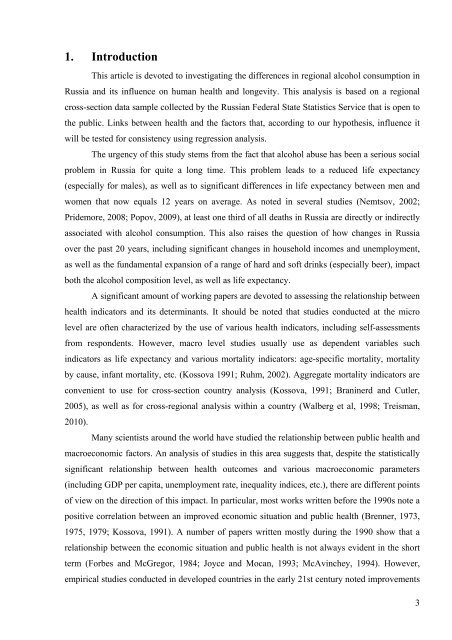REQUESTIONING OLD RUSSIAN AUTOBIOGRAPHICAL WRITINGS
REQUESTIONING OLD RUSSIAN AUTOBIOGRAPHICAL WRITINGS
REQUESTIONING OLD RUSSIAN AUTOBIOGRAPHICAL WRITINGS
You also want an ePaper? Increase the reach of your titles
YUMPU automatically turns print PDFs into web optimized ePapers that Google loves.
1. Introduction<br />
This article is devoted to investigating the differences in regional alcohol consumption in<br />
Russia and its influence on human health and longevity. This analysis is based on a regional<br />
cross-section data sample collected by the Russian Federal State Statistics Service that is open to<br />
the public. Links between health and the factors that, according to our hypothesis, influence it<br />
will be tested for consistency using regression analysis.<br />
The urgency of this study stems from the fact that alcohol abuse has been a serious social<br />
problem in Russia for quite a long time. This problem leads to a reduced life expectancy<br />
(especially for males), as well as to significant differences in life expectancy between men and<br />
women that now equals 12 years on average. As noted in several studies (Nemtsov, 2002;<br />
Pridemore, 2008; Popov, 2009), at least one third of all deaths in Russia are directly or indirectly<br />
associated with alcohol consumption. This also raises the question of how changes in Russia<br />
over the past 20 years, including significant changes in household incomes and unemployment,<br />
as well as the fundamental expansion of a range of hard and soft drinks (especially beer), impact<br />
both the alcohol composition level, as well as life expectancy.<br />
A significant amount of working papers are devoted to assessing the relationship between<br />
health indicators and its determinants. It should be noted that studies conducted at the micro<br />
level are often characterized by the use of various health indicators, including self-assessments<br />
from respondents. However, macro level studies usually use as dependent variables such<br />
indicators as life expectancy and various mortality indicators: age-specific mortality, mortality<br />
by cause, infant mortality, etc. (Kossova 1991; Ruhm, 2002). Aggregate mortality indicators are<br />
convenient to use for cross-section country analysis (Kossova, 1991; Braninerd and Cutler,<br />
2005), as well as for cross-regional analysis within a country (Walberg et al, 1998; Treisman,<br />
2010).<br />
Many scientists around the world have studied the relationship between public health and<br />
macroeconomic factors. An analysis of studies in this area suggests that, despite the statistically<br />
significant relationship between health outcomes and various macroeconomic parameters<br />
(including GDP per capita, unemployment rate, inequality indices, etc.), there are different points<br />
of view on the direction of this impact. In particular, most works written before the 1990s note a<br />
positive correlation between an improved economic situation and public health (Brenner, 1973,<br />
1975, 1979; Kossova, 1991). A number of papers written mostly during the 1990 show that a<br />
relationship between the economic situation and public health is not always evident in the short<br />
term (Forbes and McGregor, 1984; Joyce and Mocan, 1993; McAvinchey, 1994). However,<br />
empirical studies conducted in developed countries in the early 21st century noted improvements<br />
3
















